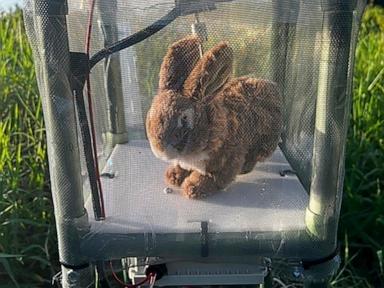UPDATE: 120 robot rabbits have just been deployed in the Everglades to combat the invasive Burmese python crisis. This innovative strategy, launched by the South Florida Water Management District and researchers from the University of Florida, aims to lure these massive snakes out of their hiding spots and significantly reduce their population.
The situation is urgent. Burmese pythons have decimated native wildlife in the Everglades, eliminating up to 95% of small mammals and thousands of birds, according to officials at Everglades National Park. “Removing them is fairly simple. It’s detection. We’re having a really hard time finding them,” stated Mike Kirkland, lead invasive animal biologist. The innovative robot rabbits are part of a broader effort to reclaim Florida’s delicate ecosystem.
These robot rabbits mimic real marsh rabbits in appearance, movement, and even scent, making them prime targets for hungry pythons. Each robot, costing around $4,000, is equipped with solar power, emits heat, and can be switched on and off remotely. They are monitored through video cameras that trigger alerts when a python approaches, allowing quick deployment of contractors to capture the snakes.
Previously, live rabbits were used for this purpose, but the costs and logistical challenges proved prohibitive. “They look like a real rabbit,” Kirkland emphasized, highlighting the potential effectiveness of this new approach. The robots were introduced this summer as part of an experimental phase, and early feedback is promising.
Florida’s python population is staggering, with estimates ranging from tens of thousands to as high as 300,000 snakes. Female pythons can lay between 50 and 100 eggs at a time, exacerbating the issue. Since 2000, over 23,000 pythons have been removed from the wild, yet the battle continues with these predators averaging between 10 and 16 feet (3 to 5 meters) in length.
Ron Bergeron, a member of the water district governing board, stressed the importance of each python removed, stating, “Every invasive python that is removed makes a difference for Florida’s environment and its native wildlife.” The situation is dire; pythons have few natural enemies and pose a significant threat to the local ecosystem.
The Florida Fish and Wildlife Conservation Commission conducts an annual “Florida Python Challenge,” offering cash prizes for the most pythons caught. In July 2023, 934 participants captured 294 pythons, with one individual taking home $10,000 for capturing 60 snakes.
As the robot rabbit initiative unfolds, officials remain hopeful. “This part of the project is in its infancy,” Kirkland acknowledged. “We are confident, though, that this will work once we are given enough time to work out some of these details.”
The deployment of robot rabbits is a significant step forward in the ongoing fight against invasive species in Florida. With the potential to reshape the Everglades’ ecosystem, the world watches closely as this groundbreaking project progresses.
Stay tuned for more updates as this story develops.







































































